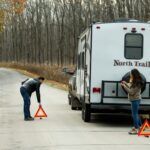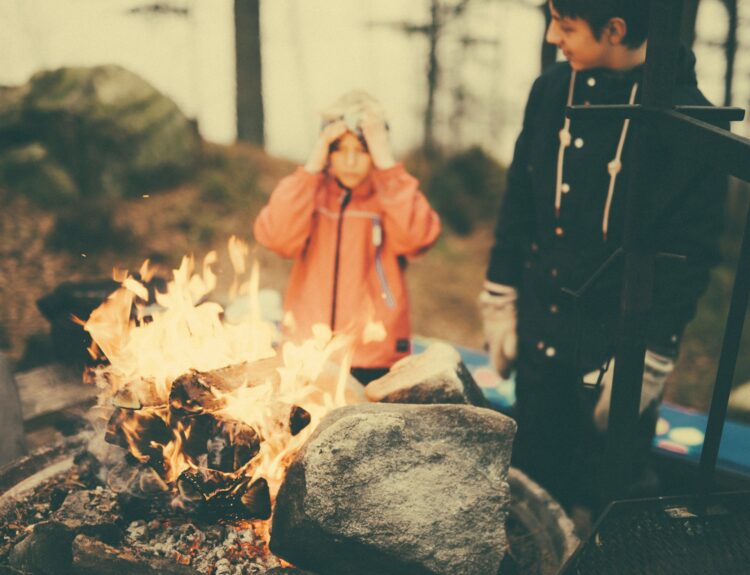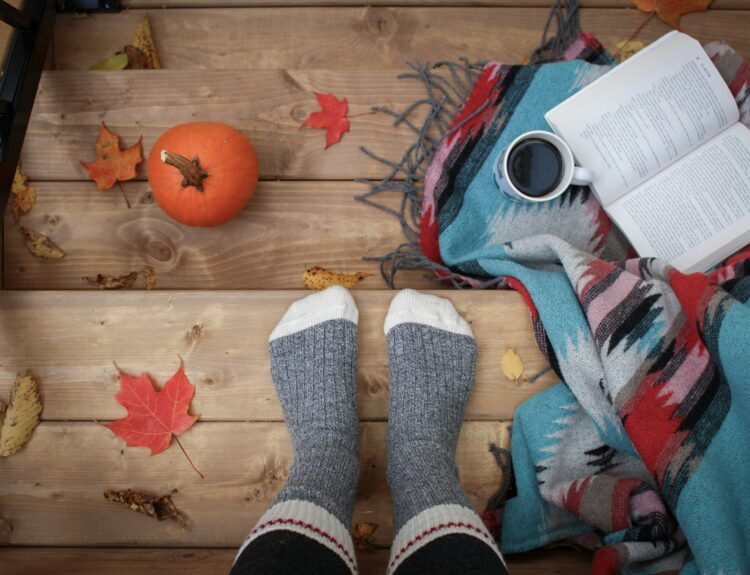Knowing how to build a proper campfire is an essential skill for any camper. However, creating the “perfect” campfire requires more than just stacking wood and striking a match. It involves choosing the right place, using the right materials, and practicing responsible fire safety. In this guide, we’ll walk you through everything you need to know to master the art of building the perfect campfire.
Key takeaways
- Choose a safe and legal location for your campfire by checking local regulations and assessing your surroundings.
- Gather essential materials, including tinder, kindling, and dry firewood, to build a strong and sustainable fire.
- Use proven fire-lay techniques like the Teepee, Log Cabin, or Lean-To to suit different camping needs.
- Practice fire safety by keeping water or a fire extinguisher nearby and never leaving your fire unattended.
- Fully extinguish your fire using water and stirring the ashes until they are completely cool to the touch.

Choosing the Right Location
Before you strike a match, deciding the right spot for your campfire is crucial for both safety and efficiency. Not all locations are suitable for a fire, and many areas have strict regulations regarding where and when fires can be built. In this section, we’ll cover how to assess the environment, identify the safest spot, and ensure your fire complies with local laws. A properly placed campfire protects both you and the environment while making the fire easier to keep and control.
Understanding Local Regulations
Local fire regulations differ from state to state in the United States. While some rules are universal—like maintaining a safe distance from flammable objects—others vary due to regional wildfire risks and local ordinances.
Most states require campfires to be built in designated fire rings or pits at established campsites and mandate a minimum clearance of about 15 feet from tents, trees, and other flammable materials. Always check with your local forestry service, park authority, or county office for specific guidelines.
Assessing the Environment
Selecting the right location also means thoroughly assessing your environment. Choose a flat, open area free of overhanging branches, dry grass, and heavy brush. Consider the wind direction, as strong gusts can cause embers to travel unexpectedly. If a fire ring isn’t available, create your own fire bed by clearing vegetation down to the bare soil.
With both regulatory and environmental factors in mind, you’re ready to gather the essential materials for your campfire.
Gathering Essential Materials
A successful campfire depends on having the right materials. From tinder that catches the initial spark to fuel logs that sustain the fire, selecting and arranging the wood properly is key. This section explains the different types of firewood, the importance of using dry, seasoned wood, and additional tools that simplify fire building.
Types of Firewood
A well-constructed campfire requires three types of wood:
- Tinder: small, dry materials (like dry leaves, pine needles, or shredded paper) that catch fire easily.
- Kindling: small sticks or branches that help build the flame.
- Fuel Wood: larger logs that provide lasting heat. Dry, seasoned wood ensures a cleaner, more efficient burn.
Let’s explore the additional tools that enhance your fire-building process.
Additional Tools and Supplies
Along with the right firewood, having the proper tools is essential:
- Fire Starters: waterproof matches, lighters, or fire-starting sticks ensure reliable ignition.
- Safety Equipment: Always carry a water source, shovel, and fire extinguisher.
- Fireproof gloves: Protect your hands while handling hot materials or adjusting logs.
Now that you have gathered both the firewood and essential tools, you’re ready to start building your campfire structure.

Building the Campfire
With your materials and tools at hand, it’s time to construct your campfire. Different fire-lay techniques suit different needs, whether for quick heat, long-lasting warmth, or cooking. This section covers the most effective fire structures—including the Teepee, Log Cabin, and Lean-To—and offers detailed, step-by-step instructions for each.
Preparing the Fire Bed
A solid foundation is crucial for any campfire. Start by clearing the area of leaves, twigs, and flammable debris. If no natural fire ring is present, encircle your cleared area with rocks to help contain the fire. You might also dig a shallow pit to help control embers and prevent the fire from spreading.
After preparing a safe and sturdy fire bed, the next step is to arrange your wood using effective fire-lay techniques.
Fire Lay Techniques
Below are detailed, step-by-step instructions for three common fire-lay methods:
Teepee Fire:
- Arrange the Tinder: Place a small pile of tinder in the center of your fire bed.
- Position the Kindling: Stand several pieces of kindling around the tinder in a cone shape, leaning them inward to allow the flames to rise through the structure.
- Ignite the Tinder: Light the tinder at many points to ensure an even burn.
- Add Fuel Wood: Once the kindling is burning steadily, gradually add larger fuel logs while maintaining the cone structure to promote airflow.
Log Cabin Fire:
- Create a base: Place two parallel logs on either side of your tinder and kindling pile.
- Layer Perpendicular Logs: Stack smaller logs on top of the base logs, alternating directions to form a square or rectangular frame.
- Ensure Airflow: Leave gaps between the logs to allow air circulation.
- Light the Center: ignite the tinder in the center. The surrounding logs will catch fire gradually, sustaining a longer burn.
Lean-To Fire:
- Set a Support Log: Lay one thick log horizontally on the ground to serve as a support.
- Lean Kindling Against It: Arrange long pieces of kindling at an angle against the support log, creating a sloping structure.
- Place Tinder Beneath: Position tinder and small kindling under the leaned sticks.
- Ignite the Tinder: Light the tinder, so the flames climb the kindling; this setup is especially effective in windy conditions.
Having mastered these fire-lay techniques, it’s time to bring your campfire to life through proper ignition.
Igniting the Fire
Starting your campfire can be challenging, especially under adverse weather conditions. This section outlines the best methods for igniting your fire and keeping it burning steadily. Learn how to use fire starters effectively and maintain your fire without smothering it.
Using Fire Starters Effectively
- Proper Positioning: Hold your match or lighter close to the tinder and ignite from downwind to ensure the flame catches.
- Enhanced Techniques: Use fire-starting sticks or homemade fire starters like wax-dipped cotton balls to boost ignition.
- Avoid chemicals: Steer clear of lighter fluid or gasoline to prevent dangerous flare-ups.
Maintaining the Fire
- Gradual Fuel Addition: Slowly add fuel logs to sustain the fire, ensuring not to overcrowd the flames.
- Airflow Management: Adjust log placement to promote sufficient airflow, which is vital for a steady burn.
- Consistent Monitoring: Keep extra tinder and kindling at the ready to rejuvenate the fire if it starts to wane.
Once your fire is burning consistently, it’s time to shift your focus to ensuring safety around the campfire.

Campfire Safety Tips
While a campfire adds charm to your outdoor adventure, it also carries inherent risks. This section outlines essential safety practices to help you maintain control of your fire, prevent wildfires, and protect both people and the environment.
Supervision and Monitoring
- Stay Vigilant: Never leave your campfire unattended; designate a responsible person to monitor it at all times.
- Emergency Readiness: Keep a bucket of water or a fire extinguisher nearby to address any unexpected flare-ups.
- Use Safe Materials: Only add approved, burnable materials to your fire, and avoid non-flammable items that could disrupt combustion.
Extinguishing the Fire Properly
- Cooling Technique: Pour water slowly over the embers, stirring with a stick or shovel to ensure even cooling.
- Check for Cold Ashes: Continue adding water until all embers and ashes are cold to the touch.
- Alternative Methods: If water is not available, use dirt or sand to smother the fire completely.
After mastering fire extinguishing, consider the environmental impact of your actions and explore sustainable camping practices.
Environmental Considerations
A responsible campfire provides warmth and ambiance and respects the natural environment. This section discusses eco-friendly practices, ensuring that your campfire leaves no lasting damage to nature.
Leave No Trace Principles
- Stick to Established Areas: Use existing fire rings or pits to avoid damaging untouched areas.
- Burn Natural Materials Only: Use only natural, unprocessed materials to minimize environmental harm.
- Clean Up Thoroughly: Fully extinguish the fire and dispose of ashes properly, leaving the site as you found it.
Embracing Leave No Trace principles sets the stage for exploring eco-friendly alternatives to traditional campfires.
Alternatives to Traditional Campfires
- Portable Camp Stoves: In areas where open fires are restricted, camp stoves provide a safe cooking option.
- Propane Fire Pits: These offer a controlled flame with lower environmental impact.
- Designated Fire Areas: When fire bans are in effect, rely on battery-operated heaters or other safe warming methods.
You’re All Set to Build the Perfect Campfire
Building the perfect campfire is a skill every camper should master. By choosing the right location, gathering the right materials, using effective fire-laying techniques, and following strict safety and environmental guidelines, you can create a campfire experience that is both enjoyable and responsible. These steps will help you have a safe and successful adventure.
Now that you know how to build a campfire, it’s time to organize your next outdoor adventure. Start planning today with RoverPass and get ready for unforgettable nights around the campfire.
Frequently Asked Questions
What’s the best way to dispose of leftover firewood and ashes?
Allow ashes to cool completely before disposal. You can scatter them over a wide area or deposit them in designated fire pits. Some campsites offer specific guidelines for disposal, so always follow local recommendations.
What should I do if the wind is too strong for a campfire?
If wind conditions are extreme, use a windscreen or opt for a Lean-To fire structure to shield the flames. In very high winds, consider postponing the fire or moving to a more sheltered location to ensure safety.
How can I make a smokeless campfire?
Using dry, seasoned wood is essential. Arrange your logs to allow for proper airflow and avoid smoldering. Pairing dry wood with ample tinder and kindling creates a strong, hot flame that minimizes smoke production.
What’s the safest way to cook over a campfire?
Use a stable grill grate or campfire tripod to secure your cooking setup. Keep a spray bottle of water nearby for flare-ups, and avoid overcrowding your fire with too much wood at once.
What should I do if my campfire won’t stay lit?
Check whether your wood is wet or unseasoned, as this can hinder ignition. Ensure you have enough tinder and kindling, and adjust the arrangement to improve airflow. Small adjustments and gradual additions of dry material can help sustain the flame.






